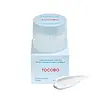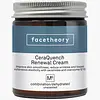What's inside
What's inside
 Key Ingredients
Key Ingredients

 Benefits
Benefits

 Concerns
Concerns

 Ingredients Side-by-side
Ingredients Side-by-side

Water
Skin ConditioningGlycerin
HumectantSqualane
EmollientCoco-Caprylate/Caprate
EmollientPolyglyceryl-3 Methylglucose Distearate
EmulsifyingCaprylic/Capric Triglyceride
MaskingPentylene Glycol
Skin ConditioningPropanediol
SolventPolyglyceryl-3 Distearate
EmulsifyingCyclohexasiloxane
Emollient1,2-Hexanediol
Skin ConditioningButylene Glycol
HumectantDiphenyl Dimethicone
EmollientDiphenylsiloxy Phenyl Trimethicone
Skin ConditioningCetearyl Olivate
Sorbitan Olivate
EmulsifyingHydrogenated Coco-Glycerides
EmollientCetearyl Alcohol
EmollientGlyceryl Stearate
EmollientPolymethylsilsesquioxane
Glucose
HumectantChlorella Vulgaris Extract
Skin ConditioningButyrospermum Parkii Butter
Skin ConditioningHydroxyacetophenone
AntioxidantSodium Polyacrylate Starch
AbsorbentAcrylates/C10-30 Alkyl Acrylate Crosspolymer
Emulsion StabilisingFructose
HumectantFructooligosaccharides
HumectantTromethamine
BufferingParfum
MaskingGlyceryl Stearate Citrate
EmollientPanthenol
Skin ConditioningHydroxyethyl Acrylate/Sodium Acryloyldimethyl Taurate Copolymer
Emulsion StabilisingHydrogenated Lecithin
EmulsifyingSodium Phytate
Xanthan Gum
EmulsifyingStearic Acid
CleansingHyaluronic Acid
HumectantEthylhexylglycerin
Skin ConditioningBeta-Glucan
Skin ConditioningCeramide NP
Skin ConditioningHydrolyzed Hyaluronic Acid
HumectantCeramide Ns
Skin ConditioningCholesterol
EmollientPhytosphingosine
Skin ConditioningSodium Hyaluronate
HumectantCeramide AP
Skin ConditioningCeramide As
Skin ConditioningCeramide EOP
Skin ConditioningWater, Glycerin, Squalane, Coco-Caprylate/Caprate, Polyglyceryl-3 Methylglucose Distearate, Caprylic/Capric Triglyceride, Pentylene Glycol, Propanediol, Polyglyceryl-3 Distearate, Cyclohexasiloxane, 1,2-Hexanediol, Butylene Glycol, Diphenyl Dimethicone, Diphenylsiloxy Phenyl Trimethicone, Cetearyl Olivate, Sorbitan Olivate, Hydrogenated Coco-Glycerides, Cetearyl Alcohol, Glyceryl Stearate, Polymethylsilsesquioxane, Glucose, Chlorella Vulgaris Extract, Butyrospermum Parkii Butter, Hydroxyacetophenone, Sodium Polyacrylate Starch, Acrylates/C10-30 Alkyl Acrylate Crosspolymer, Fructose, Fructooligosaccharides, Tromethamine, Parfum, Glyceryl Stearate Citrate, Panthenol, Hydroxyethyl Acrylate/Sodium Acryloyldimethyl Taurate Copolymer, Hydrogenated Lecithin, Sodium Phytate, Xanthan Gum, Stearic Acid, Hyaluronic Acid, Ethylhexylglycerin, Beta-Glucan, Ceramide NP, Hydrolyzed Hyaluronic Acid, Ceramide Ns, Cholesterol, Phytosphingosine, Sodium Hyaluronate, Ceramide AP, Ceramide As, Ceramide EOP
Water
Skin ConditioningGlycerin
HumectantPersea Gratissima Fruit Butter
EmollientGlyceryl Stearate Se
EmulsifyingArgania Spinosa Kernel Oil
EmollientOlea Europaea Fruit Oil
MaskingSimmondsia Chinensis Seed Oil
EmollientOlive Glycerides
EmulsifyingCetyl Alcohol
EmollientStearic Acid
CleansingRosa Moschata Oil
AstringentTocopherol
AntioxidantRetinyl Palmitate
Skin ConditioningPanthenol
Skin ConditioningSodium Ascorbyl Phosphate
AntioxidantSodium Levulinate
Skin ConditioningSodium Anisate
AntimicrobialSodium Hyaluronate
HumectantCeramide NP
Skin ConditioningUbiquinone
AntioxidantLactic Acid
BufferingFerulic Acid
AntimicrobialXanthan Gum
EmulsifyingGlyceryl Caprylate
EmollientWater, Glycerin, Persea Gratissima Fruit Butter, Glyceryl Stearate Se, Argania Spinosa Kernel Oil, Olea Europaea Fruit Oil, Simmondsia Chinensis Seed Oil, Olive Glycerides, Cetyl Alcohol, Stearic Acid, Rosa Moschata Oil, Tocopherol, Retinyl Palmitate, Panthenol, Sodium Ascorbyl Phosphate, Sodium Levulinate, Sodium Anisate, Sodium Hyaluronate, Ceramide NP, Ubiquinone, Lactic Acid, Ferulic Acid, Xanthan Gum, Glyceryl Caprylate
 Reviews
Reviews

Ingredients Explained
These ingredients are found in both products.
Ingredients higher up in an ingredient list are typically present in a larger amount.
Ceramide NP is a type of ceramide and formally known as ceramide 3.
Ceramides are intercellular lipids naturally found in our skin that bonds dead skin cells together to create a barrier. They are known for their ability to hold water and thus are a great ingredient for dry skin.
Ceramides are an important building block for our skin barrier. A stronger barrier helps the skin look more firm and hydrated. By bolstering the skin ceramides act as a barrier against irritating ingredients. This can help with inflammation as well.
If you would like to eat ceramides, sweet potatoes contain a small amount.
Read more about other common types of ceramides here:
Ceramide AP
Ceramide EOP
Glycerin is already naturally found in your skin. It helps moisturize and protect your skin.
A study from 2016 found glycerin to be more effective as a humectant than AHAs and hyaluronic acid.
As a humectant, it helps the skin stay hydrated by pulling moisture to your skin. The low molecular weight of glycerin allows it to pull moisture into the deeper layers of your skin.
Hydrated skin improves your skin barrier; Your skin barrier helps protect against irritants and bacteria.
Glycerin has also been found to have antimicrobial and antiviral properties. Due to these properties, glycerin is often used in wound and burn treatments.
In cosmetics, glycerin is usually derived from plants such as soybean or palm. However, it can also be sourced from animals, such as tallow or animal fat.
This ingredient is organic, colorless, odorless, and non-toxic.
Glycerin is the name for this ingredient in American English. British English uses Glycerol/Glycerine.
Learn more about GlycerinPanthenol is a common ingredient that helps hydrate and soothe the skin. It is found naturally in our skin and hair.
There are two forms of panthenol: D and L.
D-panthenol is also known as dexpanthenol. Most cosmetics use dexpanthenol or a mixture of D and L-panthenol.
Panthenol is famous due to its ability to go deeper into the skin's layers. Using this ingredient has numerous pros (and no cons):
Like hyaluronic acid, panthenol is a humectant. Humectants are able to bind and hold large amounts of water to keep skin hydrated.
This ingredient works well for wound healing. It works by increasing tissue in the wound and helps close open wounds.
Once oxidized, panthenol converts to pantothenic acid. Panthothenic acid is found in all living cells.
This ingredient is also referred to as pro-vitamin B5.
Learn more about PanthenolSodium Hyaluronate is hyaluronic acid's salt form. It is commonly derived from the sodium salt of hyaluronic acid.
Like hyaluronic acid, it is great at holding water and acts as a humectant. This makes it a great skin hydrating ingredient.
Sodium Hyaluronate is naturally occurring in our bodies and is mostly found in eye fluid and joints.
These are some other common types of Hyaluronic Acid:
Learn more about Sodium HyaluronateStearic Acid is a fatty acid. It is an emollient, emulsifier, and texture enhancer.
As an emollient, stearic acid helps soften skin. It aids the skin's protective barrier by preventing water loss. It also provides a gentle cleansing effect without stripping away natural oils.
Stearic acid may also be used to enhance the texture of products. It can add volume and stabilize ingredients such as water and oil. This can help water and oil ingredients from separating.
Sources of stearic acid include animal or vegetable fats/oils such as coconut or shea. It can be naturally found in butter, cocoa butter, shea butter, vegetable fats, and animal tallow.
This ingredient may not be Malassezia folliculitis, or fungal-acne safe.
Learn more about Stearic AcidWater. It's the most common cosmetic ingredient of all. You'll usually see it at the top of ingredient lists, meaning that it makes up the largest part of the product.
So why is it so popular? Water most often acts as a solvent - this means that it helps dissolve other ingredients into the formulation.
You'll also recognize water as that liquid we all need to stay alive. If you see this, drink a glass of water. Stay hydrated!
Learn more about WaterXanthan gum is used as a stabilizer and thickener within cosmetic products. It helps give products a sticky, thick feeling - preventing them from being too runny.
On the technical side of things, xanthan gum is a polysaccharide - a combination consisting of multiple sugar molecules bonded together.
Xanthan gum is a pretty common and great ingredient. It is a natural, non-toxic, non-irritating ingredient that is also commonly used in food products.
Learn more about Xanthan Gum